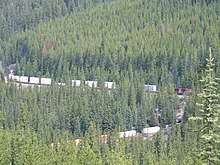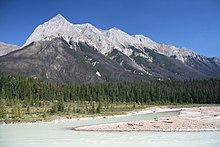Forestry in Canada
| Part of a series on the |
| Economy of Canada |
|---|
 |
| Economic history of Canada |
| Sectors |
|
| Economy by province |
| Economy by city |
The
Forest Management

Canada is the leading country for sustainable forest management with a sciences-based approach to ensure proper and sustainable management of Canadian ecosystems.[7] Almost 90% of the Canadian forests are publicly owned and controlled by their provinces and territories. Each provincial and territorial government allot early levels of harvest and require regenerative practices upon completion of harvesting[2] Additionally, for companies to harvest public lands they must produce a unique forest management plan and consult the public. 6% of Canadian forests are privately owned and must comply with provincial and federal laws and legislations.[2] 2% of the forests are federally owned and the remaining 2% are owned by Indigenous Peoples.
The governments are assisted by the National Advisory Board on Forest Research, established in 1997 and focusing on strategic issues, and the Forest Sector Advisory Council, which represents the interests of the multitude of private, non-profit and academic stakeholders in Canadian forestry. The Canadian Council of Forest Ministers, composed of 14 ministers representing the federal government and the various provinces and territories, is the main tool for dissemination of national and international policy throughout the country.[4]
History of forestry
European forestry in Canada is thought to date back to the 11th century, when Leif Erikson first landed off the coast of what is believed to be Newfoundland.[8] Large scale forestry did not begin until European settlers landed several centuries later. The area that is now Canada experienced significant deforestation during the 18th and 19th centuries, as a booming population of settlers cleared the land; this pattern was also seen elsewhere in North America. Changes in management strategies in the 20th and 21st centuries have been able to halt the trend toward deforestation.[5]
Forestry today
Forestry is a major industry in Canada, contributing over $24.6 billion in GDP to the economy in 2017.
Environmental concerns

Canada's ecosystems depend on large forested areas.
Canada is a participant in several international protocols and conferences in areas that affect its forested land. As a signatory to the
Natural Disturbances
This section needs to be updated. (March 2021) |

In 2016, 15,489,117 hectares (38,274,440 acres) of Canadian forests were destroyed by insects.
The emerald ash borer is another major concern to Canadian forests responsible for the rapid decay of forests in Manitoba, Ontario, Québec, New Brunswick, and Nova Scotia.[20] The emerald ash borer was introduced into North America from Eastern Asia in the 1990s[21] It is estimated that the beetle has caused $1.422 billion in damages since the introduction to Canada.[22] In response, Canada has responded by creating laws and regulations to reduce human-facilitated transport of the beetle. Additionally, the CFIA has cut down thousands of trees to create a buffer zone to halt the progression of the emerald ash borer.[22]
Assisted migration
Assisted migration is the act of moving plants or animals to a different habitat. In Canada, this is described as a climate change adaptation program proposal, most often discussed in the context of the relocalization of trees and forests. Indeed, as the Canadian climate gets warmer, tree species' become less adapted to the conditions of their historical southern or downhill range and more adapted to the climatic condition of areas north or uphill of their historical range.[23]
In the late 2000s and early 2010s, the Canadian provinces of Alberta and British Columbia modified their tree reseeding guidelines to account for the northward and uphill movement of forests' optimal ranges.[23] British Columbia even gave the green light for the relocation of a single species, the Western Larch, 1000 km northward.[24]
See also
- Minister of Forestry (Canada)
- Canadian Forestry Corps
- Canadian Forestry Association
- Canadian Forest Service
- Natural Resources Canada
- Tree Canada, an NGO
References
- ^ Canada, Natural Resources (2015-06-11). "how-much-forest-does-canada-have". www.nrcan.gc.ca. Retrieved 2021-02-12.
- ^ a b c d e f "The State of Canada's Forests: Annual report 2018" (PDF). Natural Resources Canada. 2018. Retrieved 2021-03-11.
- ^ Canada, Natural Resources (2013-07-10). "overview-canadas-forest-industry". www.nrcan.gc.ca. Retrieved 2021-03-11.
- ^ a b c "Forestry policies, institutions and programmes - Canada". Food and Agriculture Organization. Retrieved 2013-12-10.
- ^ a b "Chapter 2: Forests and the Evolution of the Modern World" (PDF). State of the Worlds Forests. Food and Agriculture Organization. 2012. p. 14.
- ^ Canada, Natural Resources. "Canada ranks second among leading global wood product exporters | Selective Cuttings | Natural Resources Canada". cfs.nrcan.gc.ca. Retrieved 2021-03-11.
- ^ "Canada's Forest-related Contributions to Sustainable Development" (PDF). United Nations. 2019.
- ISBN 0-8160-4716-2.
- ^ a b "Forest Fact Book 2018-2019" (PDF). Natural Resources Canada. 2019. pp. 2, 8, 9. Retrieved 2019-09-23.
- ^ a b "Forests". Government of Canada. 2013-11-21. Retrieved 2013-12-10.
- ^ "Forest product consumption and production". Food and Agriculture Organization. Retrieved 2013-12-10.
- ^ "Forest products trade". Food and Agriculture Organization. Retrieved 2013-12-10.
- .
- ISSN 1366-9516.
- ^ "Annual Regional Temperature Departures". Environment Canada. Archived from the original on January 18, 2012. Retrieved April 2, 2012.
- .
- ^ Canada, Natural Resources (2020-10-02). "Mountain pine beetle (factsheet)". www.nrcan.gc.ca. Retrieved 2021-03-25.
- ^ "Mountain Pine Beetle". Province of British Columbia. Archived from the original on 2012-12-30. Retrieved 2013-08-10.
- ^ "Wildfires". Government of Canada. Retrieved 2013-12-10.
- PMID 20879922.
- ^ Government of Canada, Public Services and Procurement Canada. "Information archivée dans le Web" (PDF). publications.gc.ca. Archived from the original (PDF) on 2023-06-29. Retrieved 2021-02-12.
- ^ a b Government of Canada, Public Services and Procurement Canada. "Information archivée dans le Web" (PDF). publications.gc.ca. Retrieved 2021-03-11.
- ^ a b Williams, Mary I.; Dumroese, R. Kasten (2014). "Assisted Migration: What It Means to Nursery Managers and Tree Planters" (PDF). Tree Planters' Notes. 57 (1): 21–26.
- ISSN 0264-8377.

